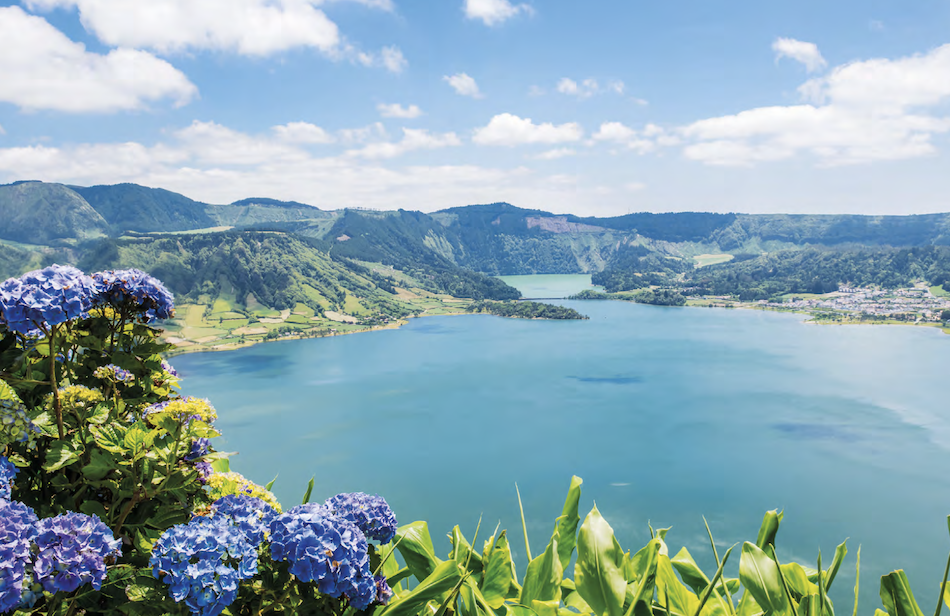By Caroline Montpetit
Far from major tourist spots, the nine islands of the Azores offer peaceful landscapes, expansive marked hiking trails for all levels, distinct local culture, and springlike weather all year long
In the Atlantic Ocean off the coast of Iberia is a group of nine volcanic islands known collectively as the Azores. An autonomous region of Portugal, the archipelago lies about 1,500 kilometres (930 miles) west of Lisbon. Once a valued port of call for explorers, the Azores are today a little-known tourist destination but have the infrastructure to ensure that visitors will have a comfortable stay, and a vacation there costs much less than a European sojourn.
Flights from Canada land in São Miguel, the largest and best known of the islands, or in Terceira. These points of entry are a gateway to discovering the other islands, from the peaceful Graciosa to the mountainous Pico—home to Mount Pico, a dormant volcano and the highest peak in Portugal. And you truly are in Portugal, even if the archipelago’s history and geography mean that the Azores have their own distinct identity.
To visit all nine islands (we spent time on Graciosa and Terceira), you’d need to make several trips, as the islands are a fair distance from one another. Azores Airlines keeps them connected, and boats also make the rounds, though their schedules are less regular than the airline’s. And once you’re on an island, you need to think about renting a car if you want to get around on your own.
Graciosa, the Contemplative
Our first experience on Graciosa, one of the smallest islands—about 12 kilometres long by eight kilometres wide (about seven and a half by five miles)—was a therapeutic bath in the Carapacho hot-springs spa (Termas do Carapacho). To cap off your visit, you can enjoy the swimming pools built right into the rocky shoreline and kept full by the ocean.
Generally speaking, the Azores have very few sandy beaches—the shoreline is carved out of volcanic rock. Still, the locals swim in the ocean all year long, even in bad weather, which is more frequent in winter. A good plan after swimming is to settle into Estrela do Mar, a laid-back restaurant located on the southern end of the island, to enjoy some deliciously prepared fresh- caught seafood.
While not all Azoreans are practis- ing Catholics, most take the various celebrations of Catholic feasts very seriously. During our stay, a few weeks after Easter, the branches of the dracaena plants in the main square of Santa Cruz (the capital of Graciosa) were still decorated with intricate lacework made locally for celebrations of feasts of the Holy Spirit.
Every year, local people, barefoot and sometimes with stones on their heads, climb the steep slope that leads to the Nossa Senhora da Ayuda (“Our Lady of Help”) hermitage to thank the senhora for keeping the hurricanes far from the islands or perhaps for al- lowing a young person to complete her studies. The building, which includes a lovely collection of 18th-century azulejos (glazed tiles), is often closed in off-peak periods, but the site offers a pleasant view of Santa Cruz.
Terceira, the Proud
The Azores were formed by a series of volcanic eruptions on the ocean floor. Even today, it’s possible to visit impressive volcanic caves on several islands. On Terceira, we went to the cave at Algar do Carvão (“Cavern of Coal”), which is open to the public every day from March to October. As you descend the stairs, you get the dizzying impression that you’re heading into the bowels of the earth. It’s an experience not to be missed. Back at the surface, you can admire the attractive vineyards spread through- out the island’s hills and bordered by black volcanic rocks.
After so many colourful expeditions and changes of scene, our visit came to a wonderful end in Angra do Heroismo (or Angra), the capital of Terceira, on the island’s southern coast. The city, which was badly shaken by an earthquake in 1980, has been recognized as a UNESCO World Heritage Site, and for good reason— Angra feels like a quiet mini-Lisbon. You can climb Monte Brasil to take in the view of the Bay of Angra to the west and the Bay of Fanal to the east. In the city itself, the Duke of Terceira Garden, perched high on a hill, features flowers, plants, and trees from around the world, surrounded by church spires and colourful cloisters.
From there, we returned on foot to our comfortable hotel, Terceira Mar, which has a saltwater pool and offers a fabulous panorama of the sea and the coast—the perfect spot to rest up before catching the flight home.






